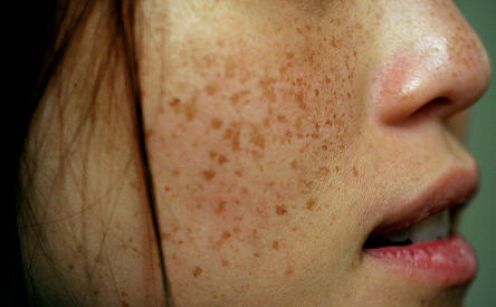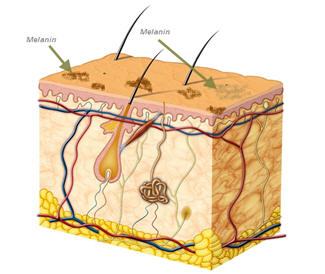Hyperpigmentation, Discoloration, Brown Spots, Age Spots are the main complaints for which people seek out cosmetic procedures.
Hyperpigmentation is the darkening of an area of the skin caused by an increase in melanin. Hyperpigmentation can be genetic, hormonal, heat /chemical/ friction (usually a post inflammatory response), or environmentally based (sun or photodamage).
There are various forms of hyperpigmentation.
Age Spots (also referred to as “sun” or “liver” spots) are formally termed “lentigines“. They are small, flat, round spots on the skin that begin to appear later in life in sun-exposed areas and are usually found on older adults on the arms, face, neck and back of the hands or other areas frequently exposed to the sun. A single spot is reffered to as a lentigo.
Solar Lentigines – sun spots and dark freckles appear to the sun.

Melasma (sometimes also called Chloasma) is similar in appearance to age spots but darkens larger areas of skin. The actual cause of melasma is unknown, but it is known to be related to both hormonal levels and exposure to sunlight.
Pregnancy, for example, can trigger overproduction of melanin, causing the “mask of pregnancy” on the face (cheeks, forehead, or temples) and darkened skin on the abdomen and other areas.
This type of hyperpigmentation can be hereditary, or triggered by hormonal changes. Women who take birth control pills or hormone replacement therapy may also develop hyperpigmentation because their bodies undergo similar kind of hormonal changes that occur during pregnancy. If treatment is stopped it will return.
The lighter it appears the deeper it is and the longer it takes to treat.

Freckles – light brown small flat spots that appear on cheeks and nose. Freckles are thought to develop as a result of a combination of genetic tendency and sun exposure. They are usually present when young and get more with ageing.
Post-Inflammatory Hyperpigmentation – is light in color, deep in the dermis. Some causes of post-inflammatory hyperpigmentation: acne, rashes like psoriasis and eczema, burns, irritation from shaving, plucking, ingrown hairs, waxing and electrolysis.
Brown Spots and Hyperpigmentation – reduction treatments are more difficult and not always satisfactory.
What cause Hyperpigmentation?
 Your skin is made of two
primary layers; the epidermis is the surface, and the dermis lies beneath
it. Located near the base of the epidermis are specialized cells, called
melanocytes, which produce the pigment melanin.
Your skin is made of two
primary layers; the epidermis is the surface, and the dermis lies beneath
it. Located near the base of the epidermis are specialized cells, called
melanocytes, which produce the pigment melanin.
Melanin gives your skin its normal color, and it is transported into new skin cells where it serves a protective role by absorbing harmful rays of sunlight that would otherwise damage the cells.
The body actually produces extra melanin in response to sun exposure, and this is why you tan in the sun. However, after years of sun exposure, melanocytes in certain areas of the skin may overproduce melanin. As accumulating melanin gradually becomes more visible, an brown spots develops.
Genetics also influences how likely a person is to develop age spots.
It would be your responsibility for controlling and preventing hyperpigmentation, brown spots, age spots, freckles by avoiding unneccessary sun exposure and applying sunblock with SPF 15 or more.
Several safe and effective treatments are available to help lighten or reduce the appearance of discolorations. Frequently, multiple or a combination of treatments may be required for best results.
Not everyone’s skin will improve with similar treatments and brown spots can easily recur with repeated unprotected UV exposure.
With any treatment of pigmentation problems, sun exposure MUST be avoided. To maintain results from a treatment and to prevent any further pigmentation damage from occurring, use of a physical block sunscreen with SPF of 15 or higher is mandatory. Also, maintenance treatments of the variouse therapies may be necessary.
It is very important to have any spots checked by a dermatologist to ensure they are harmless prior to seeking treatment for age spots.
During the consultation your practitioner at Svetlana’s Skin Secrets will be able to determine the best plan of treatment for your pigmentation problems.
Our treatments
Which treatment is suitable and most effective for you depends of your skin color, skin type and skin problem.
At Svetlana’s Skin Secrets we offer:
